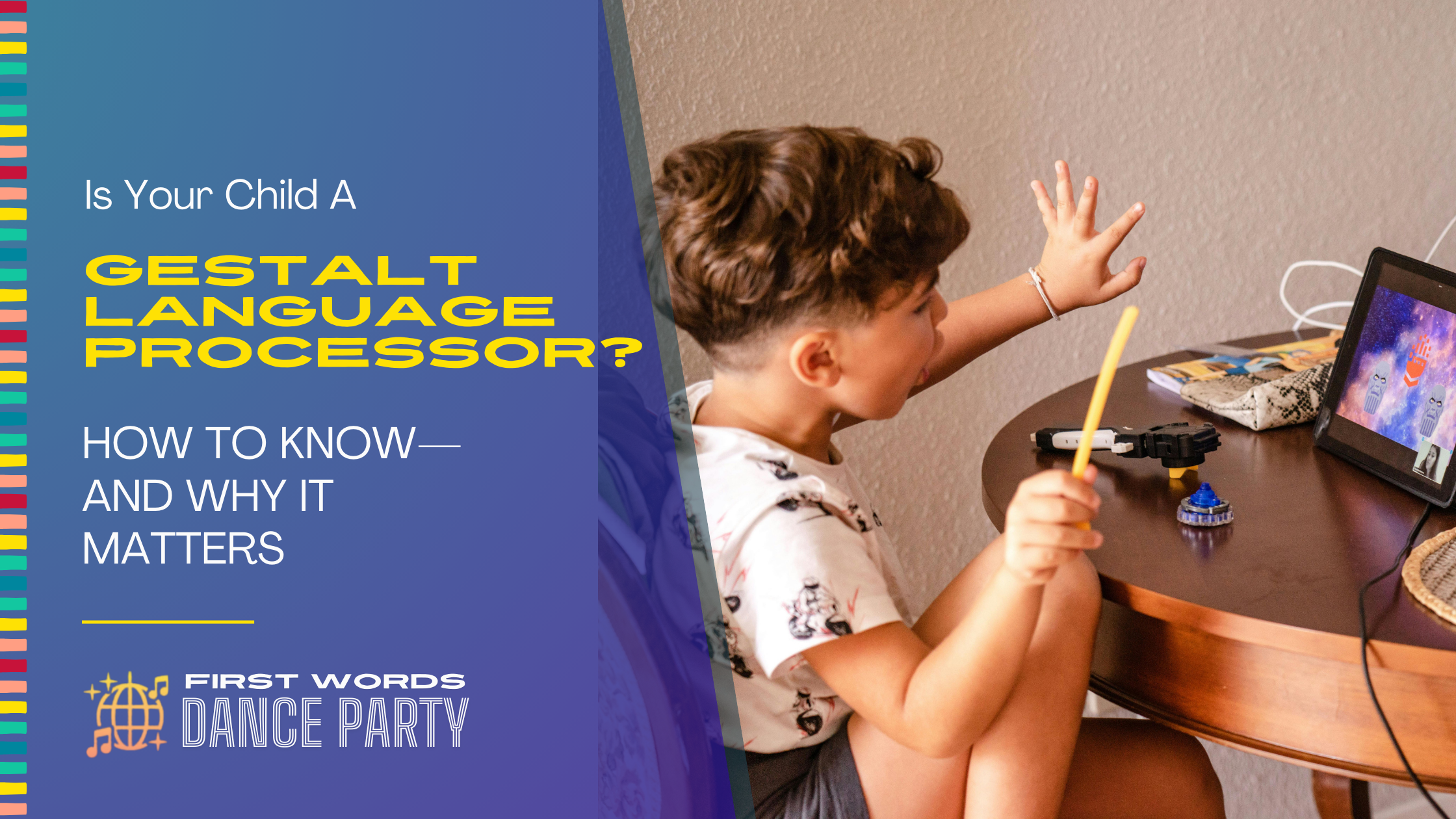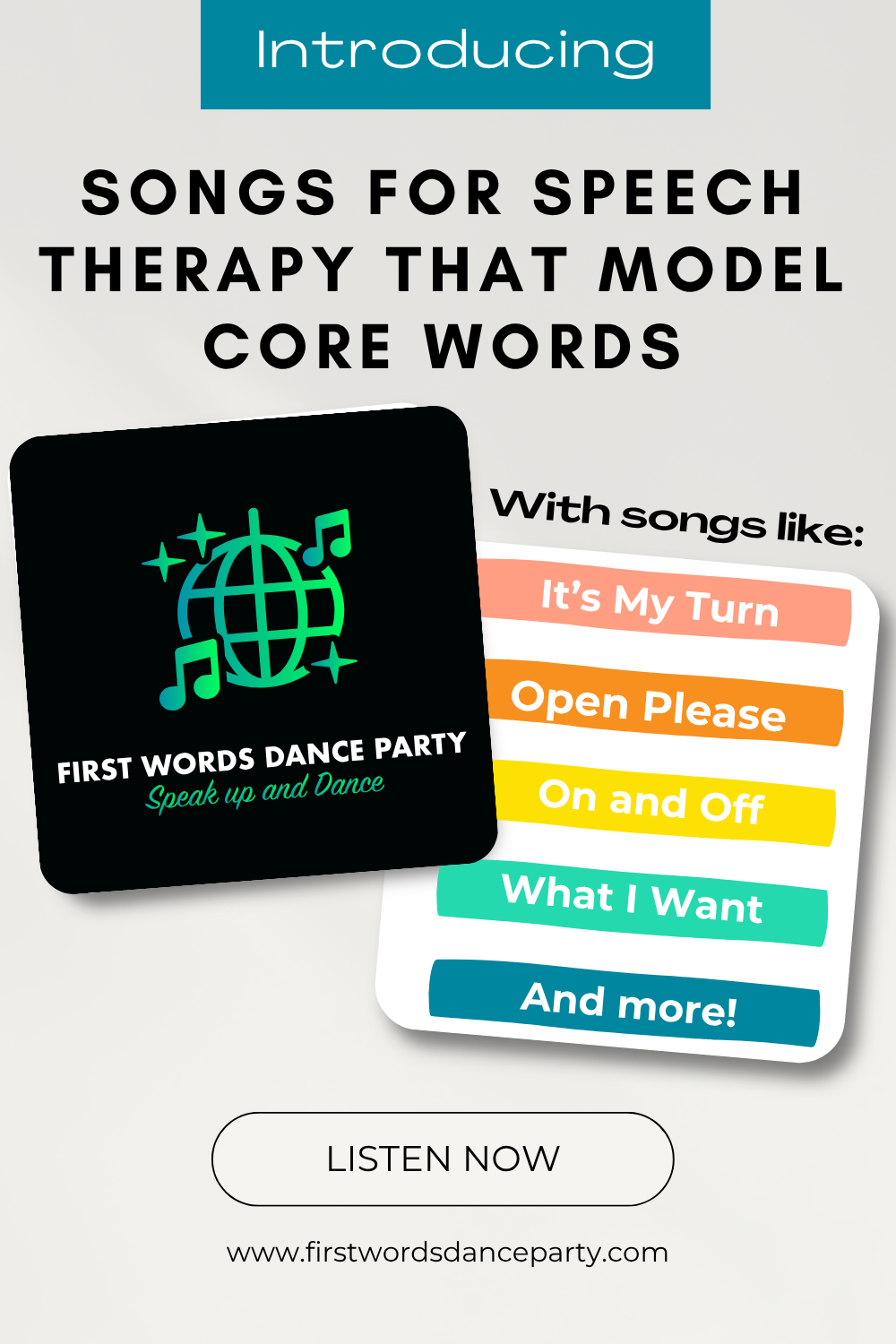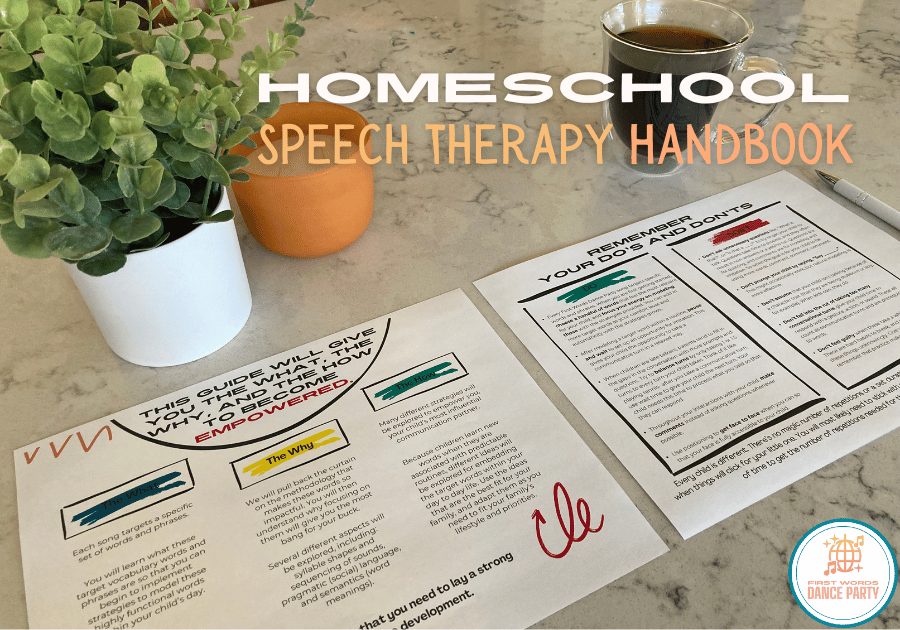What are core words? How simple but powerful words actually spark new growth
- Core Words
- 0 comments
If you’ve ever heard the term “core words” from your child’s speech therapist and nodded along, thinking, “Right, right... what are those again?”, then you’ve come to the right place.
Core words are one of the simplest and most powerful tools for supporting kids with speech delays. And while core vocabulary words are immensely powerful, you don’t need to be a speech therapist to start using them successfully with your child.
Whether your child is not talking yet or is already using some words or phrases, core vocab can create a powerful bridge between where they are and where they’re headed. Modeling core words is something you can do confidently as a parent.
If your child isn’t using many words yet, you may be unsure of what to do and what not to do- and you’re not alone. Many parents I coach in early intervention feel stuck, frustrated, or overwhelmed when their child won’t imitate their words.
That’s why I started creating music for speech therapy that weaves in the strategies we use everyday in early intervention.
You can download a free guide to discover 5 easy, parent-friendly steps to use songs for speech therapy to spark connection and communication with your child. As a bonus, you’ll receive song boards with cards for every First Words Dance Party™ song, so your child can make choices and initiate.
Ready to find out how to use core words to get your little one communicating? Let’s break it down.
What Are Core Words?
Core words are the most commonly used words in language. These are words like: go, want, help, stop, more, mine, you, it, and that.
Core vocabulary words are not specific to one toy, context, or routine. They’re flexible, functional, and used in all kinds of settings across any given day.
In fact, studies across different languages and age groups have found that just 50 words account for 40–50 % of our daily communication, while 100 words cover about 60 % and 200–400 words make up nearly 80 % of what we say each day (AAC Language Lab).
That’s bonkers, right? It's amazing.
This comparatively small set of words is doing a huge amount of heavy lifting in everyday life. These are words your child hears a lot and can use to communicate a lot of different messages.
Core vocab is the ticket to functional communication for kids with speech delays. Read on to see what I mean by the term “functional”.
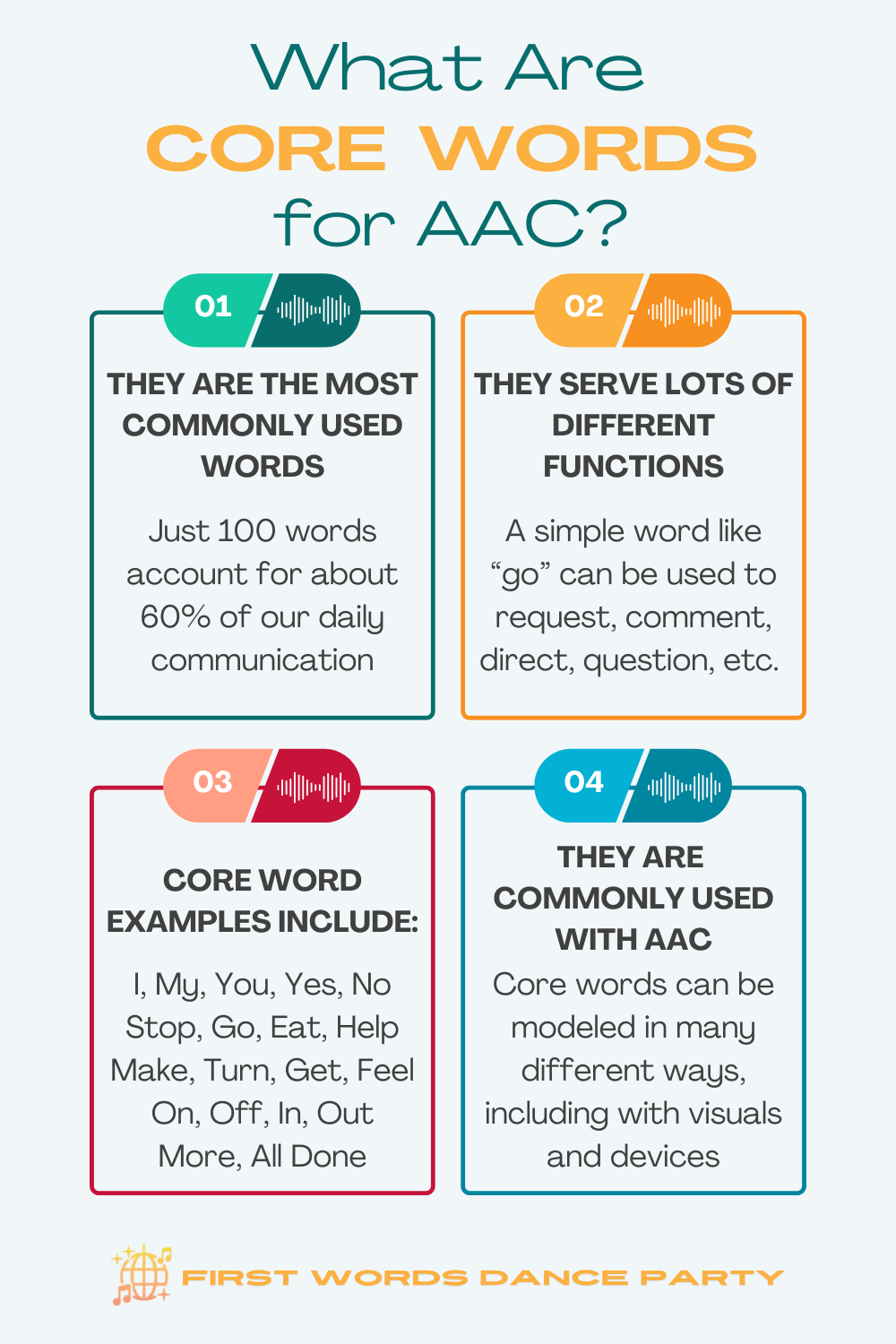
Why Core Words Are So Powerful for Kids with Speech Delays
Kids with speech delays often need support developing both receptive language (understanding) and expressive language (using words to communicate). Core vocabulary words support both.
Children with speech delays often need support with using words that can be used socially for different functions, like commenting, requesting, protesting, and seeking information.
Core Vocab is Functional
One reason core words are so powerful is because they’re flexible. Take the word go, for example. Your child can use this one word to:
Request: “Go!” when they want to be pushed on the swing
Protest: “No go!” when they don’t want to stop playing to get in the car
Comment: “Go!” while placing a car down a ramp
Direct: “Let’s go!” to invite someone to follow
Seek information: “Where go?” when daddy leaves the room

Core language is used across different contexts
Core vocab gives your child the exact words to use across lots of different contexts, and that’s what makes communication functional.
The magic about core words is this:
You don’t need to be a professional to start using them, AND
No matter what your child’s current skill level is, core words are a perfect target.
What it means to model core word vocabulary
Modeling core language means saying the word intentionally in the moment, without prompting your child.
You can model core language by using your voice, gestures, facial expressions, signs, or AAC (augmentative and alternative communication)—or all of the above. This kind of multimodal communication helps your child take in language in the way that works best for them.
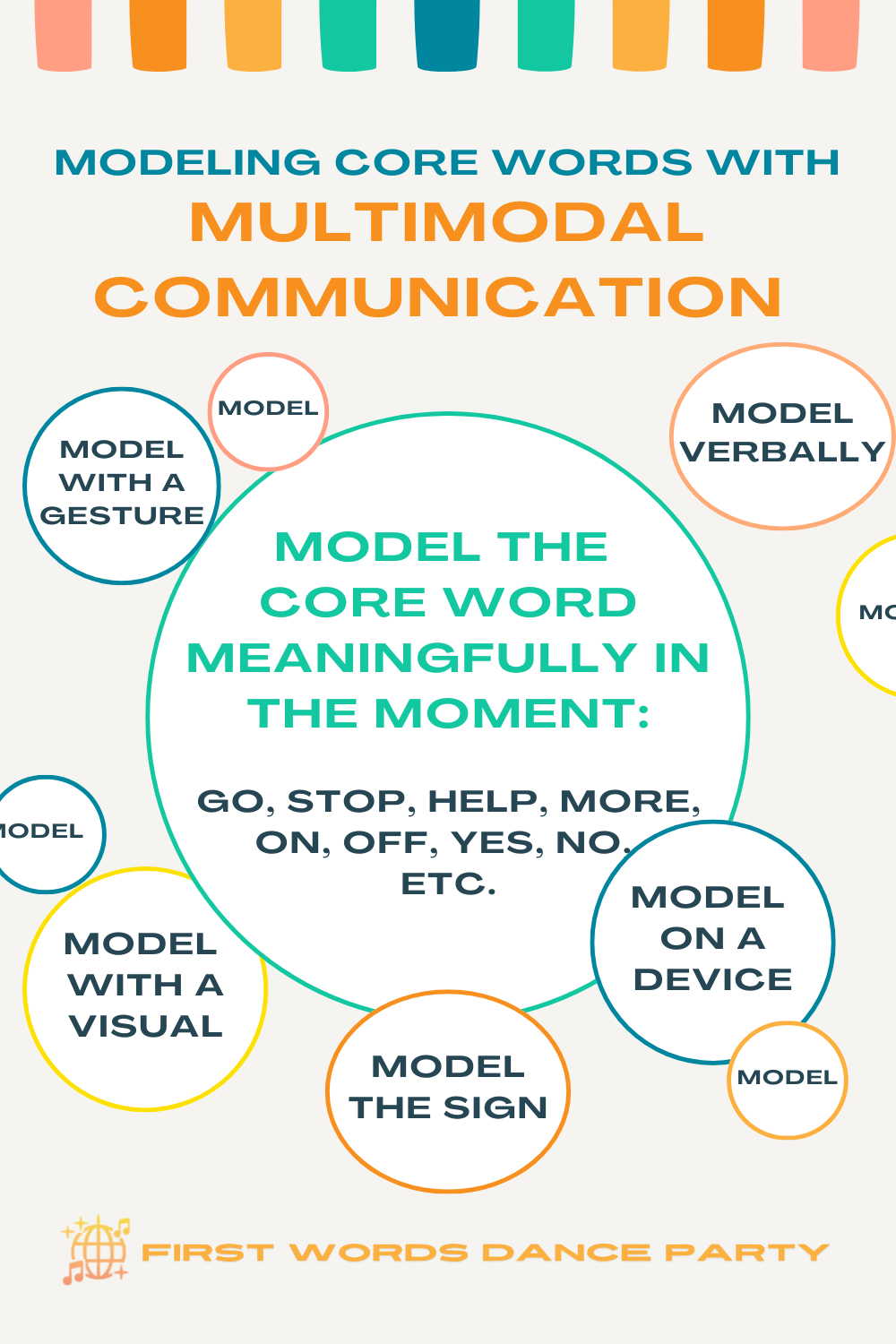
Even if your child doesn’t imitate you right away, they’re absorbing so much. Just by hearing the word emphasized in context, they’re processing and making connections. This is incredibly beneficial for increasing receptive language skills.
How to use total communication to model core words
Total communication is the approach of utilizing all kinds of different methods with a child to help them acquire language. There are lots of different ways to model core words with the total communication approach.
You can model core vocab by:
Emphasizing the word as you say it in context, pausing afterwards to draw attention to it and provide time for your child to process
Exaggerating your facial expression as you say a core word
Adding a gesture (like reaching arms out for “up”) when you say a core word
Using sign language as you say a core word (my favorite core vocab signs are: more, all done, open, go, stop, and help)
Modeling core vocabulary for AAC by pointing to a printed visual or a symbol of the word on a core board (Check out this page from Speechy Musings if you're looking for some low-tech core boards)
Using an app on an iPad or a speech-generating device to point to the symbol of the word as you say it. This is known as aided language stimulation.
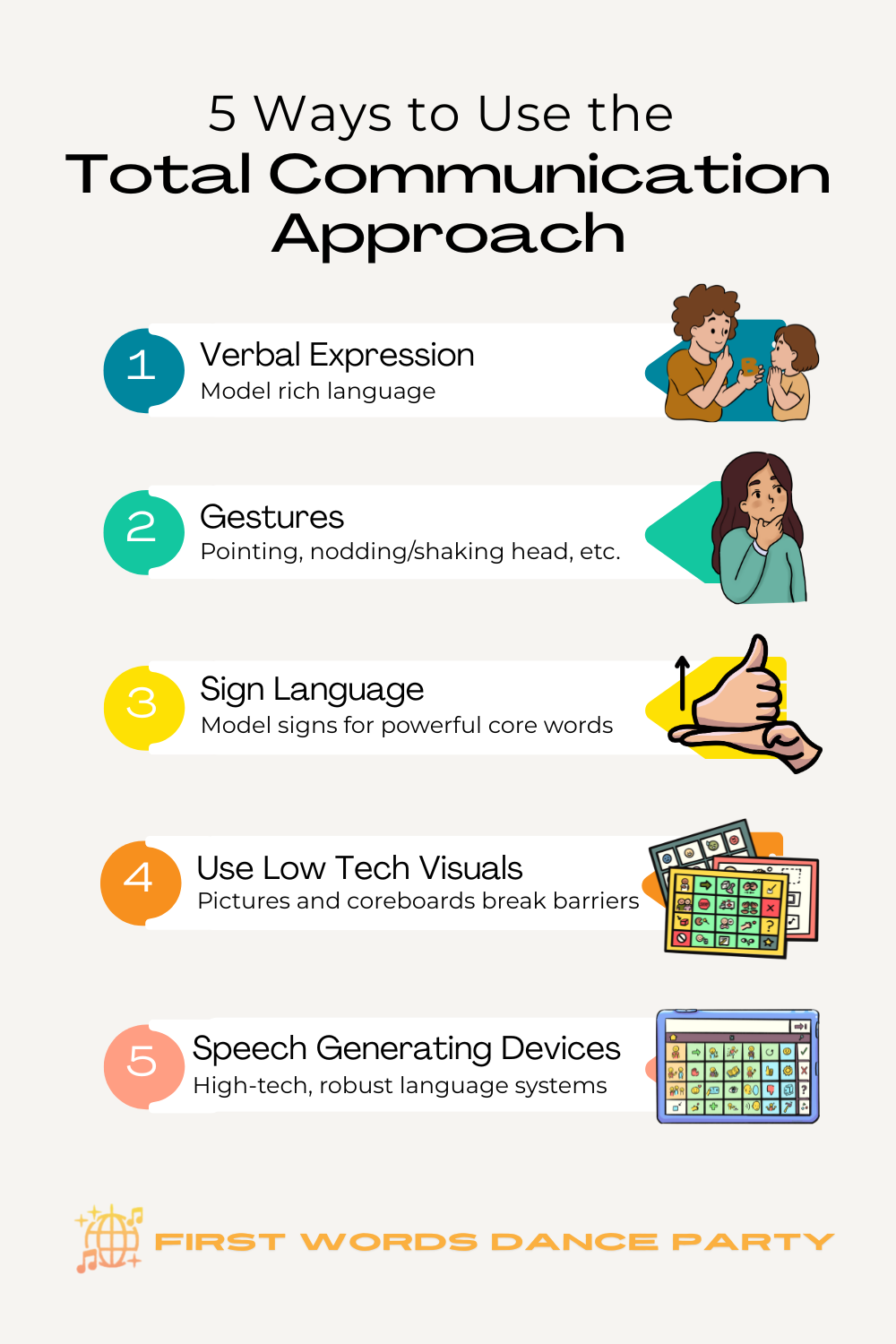
You don’t need a device to model core words for AAC
Core words for AAC are powerful—but modeling doesn’t have to be high-tech to be effective. What matters most is that your child hears and sees these meaningful words in context, over and over again.
A speech-generating device can be a game changer for many children with speech delays, but you don’t need a device to model core vocab.

Will modeling core vocabulary for AAC keep kids from talking?
Parents often wonder if using AAC will keep their child from talking, but rest assured- it’s actually the opposite. Research strongly supports that when we use AAC to support children with more avenues to communication, it encourages spoken language.
This myth-busting guide from Tobii Dynavox clears up common misconceptions and explains how AAC supports communication.
How to Model Core Vocab in Everyday Situations
Here are simple ways to model core language across the simple routines of your child’s day:
-
Playtime
“Go!” as the car rolls down the ramp
“Stop!” as you pause during a game of chase or tickling
“You want to play kitchen” as your child walks over to the play kitchen/play food -
Mealtime
“More” as you offer more crackers
“Open” as you open a container
“You’re all done” as you help your child out of their chair -
Reading Books
“You like this book.” when your child selects and hands you their favorite book
“Open the book”
“That puppy is silly!” when you comment on the character or story -
Music & Movement
“Reach up! Reach down!” while dancing with your child to a song.
“Uh oh! It stopped” between songs
“Turn on” before pressing play -
Bathtime
“Take off!” while taking off socks, pants, and shirt
“You need help” while getting your child’s shirt over their head.
“Dump out” while pouring out of cups or containers in the tub
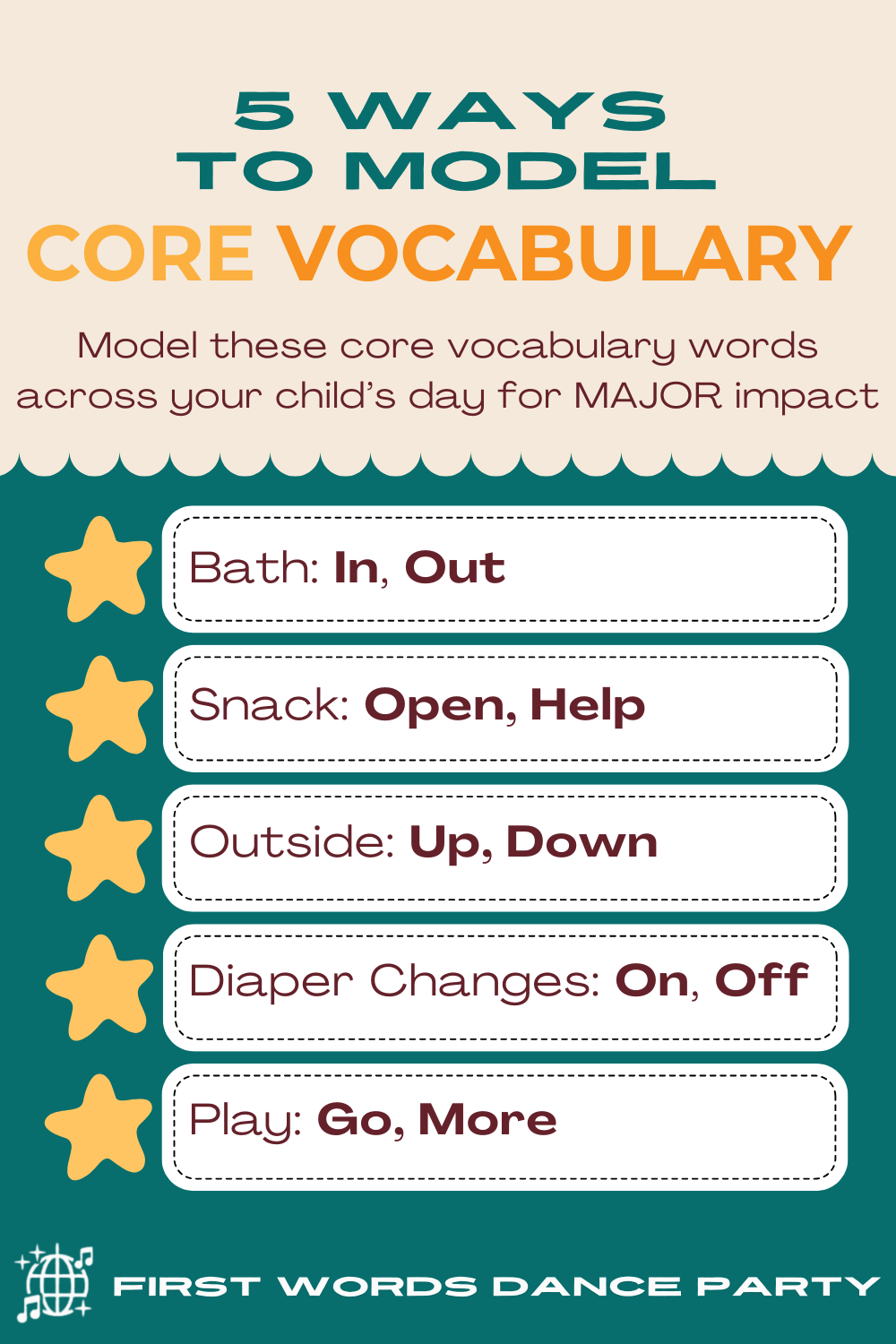
Use Multi Modal Communication Across Different Activities
You can model core words across these different routines with sign language, gestures, printed visuals, coreboards, or with higher-tech AAC like a speech generating device.
Some parents find it works best to focus on just a couple of new words each week as they get comfortable with modeling. Modeling core words for aac works really well when we teach opposite pairs, like stop/go, in/out, on/off, up/down, etc.
What About Gestalt Language Processing?
If your child communicates mostly with scripts (phrases they have echoed from songs, shows, and real-life situations), your kiddo may be a gestalt language processor.
Gestalt language processing differs from the “standard” way of processing language (analytic language processing) in that gestalt language learners process language in whole chunks, rather than in individual words.
Since gestalt language processors use and understand words in phrases first before they understand the meanings of individual words, modeling core words just looks a little bit different- but it’s still tremendously effective.
How to model core vocabulary with gestalt language processors
Instead of teaching core vocabulary words as isolated units, model them as part of scripts and routines. For example:
“Ready… set… GO!” (modeling go)
“I want more bubbles!” (modeling more)
“The kids on the bus go up and down.” (modeling up)
The key is to model, not prompt—let it be natural and part of the moment.
Even if your child is using full scripts right now, they’re still soaking in the language around them. Core words that are modeled consistently (especially in emotional or meaningful contexts) help build the foundation for self-generated language in later stages.
So yes, core word modeling absolutely has a place with gestalt language processors—you’re just offering the words a little bit differently.
Wondering if your child is a gestalt language processor? You can check out the three-part series on supporting gestalt language processors for major results:
Is your child a gestalt language processor? How to know and why it matters
The Gestalt Language Process: How to use music for quick, powerful wins
Music Makes It Easy to Model Core Language
This is where music really shines.
Songs are naturally repetitive and filled with core words in action. Many children’s songs and nursery rhymes naturally feature core words. In The Itsy Bitsy Spider, we hear the word out several times. In Five Little Monkeys, the word no gets modeled again and again.
These songs help children hear and engage with simple, powerful language.

In fact, many children I’ve worked with have sung their first words before ever speaking them in conversation. Melody and movement light up the brain and invite communication.
Research shows that music strongly supports brain development and language processing—read more from Harvard Health.
That’s exactly why I created First Words Dance Party—a collection of fun, catchy songs designed to support both expressive and receptive language for children with speech delays, AAC users, and both analytic and gestalt language processors.
First Words Dance Party: fun songs that target AAC core words
Each song supports both expressive and receptive language by targeting specific core words. Whether your child is using signs, speech, AAC, or a mix of all three, these songs make it easy—and fun—to model meaningful language every day.
Here are a few examples:
“Open”: A simple yet powerful dance-y little number that models the core words I, need, help, open, and please
“On and Off”: (You guessed it!) models on and off, as well as the core vocab words come, turn, stop, and all done through a storyline about listening to a favorite song
And “What I Want": A song that targets the core words I, want, more, on, go, open, please, and eat to support your child to make requests
These songs are catchy, dance-y, and fun—offering a much-needed break from traditional nursery rhymes while helping you build language through movement, rhythm, and connection.
You can stream First Words Dance Party on Spotify, YouTube Music, Apple Music, and anywhere else you get your music.
Now is the perfect time to start
If you’ve ever felt the weight of trying to support your child’s speech progress at home—wondering “Where do I even start?” or feeling like the things you have tried just haven’t been successful—you’re absolutely not alone. Trying to navigate speech therapy home activities that feel meaningful and manageable (rather than another exhausting to‑do) can leave you drained, second‑guessing, and wishing for something simpler.
That’s where the Homeschool Speech Therapy Handbook comes in. Designed specifically for parents (not trained therapists) who want real‑life tools, this guide breaks down exactly what to do, why it works, and how to bring speech‑therapy practice into everyday moments—snack time, bath time, play time—without turning your home into a clinic.
Framed within a song-by-song breakdown of the Speak up and Dance album, the First Words Guide will empower you to feel confident as you support your child's core vocabulary during bathtime, playtime, and mealtime. No flashcards, no drills- just meaningful, practical techniques you can extend from the songs to use throughout your day.
You’ll move from feeling overwhelmed and unsure to feeling confident and connected—watching your child engage, communicate, and grow in ways that feel easy and natural.
Final Thoughts
Supporting your child’s speech delay doesn’t have to be complicated. Modeling core words is a simple, natural, and research-backed way to make communication more accessible, and it fits beautifully into everyday routines.
Whether your child is an analytic or gestalt language processor, core vocabulary gives you a flexible foundation to work from. These powerful little words make it easier to respond to your child’s interests, build shared understanding, and model language that can be used across countless settings and situations.
You don’t need special tools or devices to get started. Your voice, your caring presence, and your willingness to learn are enough.
Ready to take the first step toward getting your little music-lover to communicate? Download 5 Easy Steps to Kickstart Communication with Music for Speech Therapy at Home.
By modeling core words consistently, you’re giving your child the building blocks they need for meaningful, everyday communication.
FAQ
Q: What are core words?
Core words are the most commonly used words in communication, like go, want, more, and help. They make up the foundation of what we say every day and are used across different contexts, which makes them incredibly powerful for building language.
Q: Why are core words important for children with speech delays?
Because they’re flexible and used frequently, core words give children countless opportunities to communicate their needs, wants, and feelings. For children with speech delays, core words are easier to model consistently and can support both expressive and receptive language growth.
Q: My child only says a couple of words. Are they too behind to try this?
Not at all. Core words are perfect for children who are just starting to communicate—whether they’re saying a few words, using signs, or are currently nonspeaking. Core words help support early functions like requesting, protesting, commenting, and more.
Q: Do I need a high-tech device to model AAC core words?
Nope! You can model core words using your voice, signs, gestures, printed visuals, or a low-tech communication board. AAC doesn’t need to be high-tech to be meaningful. Modeling is about input, not technology.
Q: What is aided language stimulation?
Aided language stimulation is when an adult points to a symbol on a speech-generating device or coreboard while speaking. It’s the best way to model AAC and naturally guide a child to use AAC without using outdated methods like hand-over-hand.
Q: What is multimodal communication?
Multimodal communication means using more than one way to communicate. That might include speech, signs, gestures, visuals, AAC, facial expressions, or even body language. It gives children multiple ways to understand and express themselves, which is especially helpful for kids with speech delays and language processing differences.
Q: My child is probably a gestalt language processor. Can this help them?
Yes! You can model core words inside natural scripts and routines. For example, if your child echoes “Red. I see something red.” from a video, you can model “see” by pointing to your eyes and exaggerating your facial expression. Of, if your child uses a device or printed coreboard, you can point to “see” when you say the phrase. Even if your child isn’t using single words yet, they are absorbing this input for later use. Just model without pressure.
Q: What are core words vs fringe words?
Core words are general, high-frequency words like go, want, more, that. They work across many situations. Fringe words are more specific to specific contexts or settings (like cookie, train, or Grandma). Both are important, but core words offer more flexibility across routines.
Q: What if my child doesn’t imitate the word I model?
That’s okay! Language learning starts with input. Your child doesn’t have to repeat the word for it to be meaningful. The more they see and hear words in context, the more connections they’ll build.
We model language to babies and young toddlers for a loooooong time without expecting them to imitate; we just know that all of the time we expose them to language by talking to them will lay the groundwork. Try to apply this same mindset to your kiddo- you’re just modeling and letting them soak it in until they are ready to imitate.
Q: How do I know what words to start with?
Start with just a few core words that match your child’s favorite activities or routines. These words should feel natural to you and easy to model. Words like stop, go, more, all done, help, yes, and no are great starting points.
Q: Can music help with core vocabulary?
Absolutely! Music adds rhythm, repetition, and fun to communication. Many core words appear naturally in songs, making it easier for kids to hear and use them. First Words Dance Party songs are designed to support this kind of language modeling by targeting specific core words in each song.

